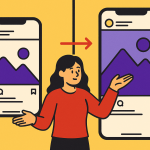Does your audience understand your message and offering within the first second of seeing your ads, posts or emails?
If not, your messaging is too complex, and that complexity is impacting your connection with your audience.
Users are exposed to thousands of ads and messages every single day, being bombarded with offers in their inboxes, feeds, google searches and phones.
With all of these messages, users’ attention and patience is fleeting, so if you fail to convey your message clearly within the first second, they’re gone.
What We Mean By A Message Is Too Complex
The easiest way to know if a message is too complex and needs to be simplified is if someone doesn’t understand within the first second. If the message requires too much thought, often, you’ve lost that person’s attention.
Commonly used complex messaging includes:
- Puns
- Unique spelling of a word
- Double entendres
- Even images that don’t have a clear meaning
- Conflicting messages across multiple channels, rather than one, uniform message
In other words, anything that requires in-depth thought to understand the actual meaning won’t maintain your audiences’ attention, because the last thing they want to do is decipher what you’re saying.
Simplicity Sticks, While Complexity Creates Confusion
Now more than ever, the human brain craves clarity, especially if the end goal is to encourage them to make a purchase decision.
When your message is simple:
- It’s easier to process
- It’s more likely to be remembered
- It creates a stronger emotional response
Conversely, a complex message creates friction. If your audience is required to stop and think hard, you’ve lost them.
The Power of Simplicity Across Your Channels
Simple messaging across all your channels will enable you to pass on your message in a clear, digestible way that allows your audience to understand your offering and what you’re trying to say.
- Paid Ads: Your audiences’ attention is fleeting, so using a single, powerful idea will perform better than an overly complex one in which the message doesn’t get delivered.
- Email Marketing: Short, direct subject lines drive more opens than ones which are clever yet vague.
- Social Media: TikToks, Reels, and Stories perform best when they deliver a clear, memorable impression.
- Landing Pages: Conversions increase when you remove the distractions, and guide visitors towards one action (rather than various ones which generates confusion).
But don’t get it confused, simplicity across these channels isn’t about cutting corners, it’s purely about sharpening your focus, so that your customers get the clear message without it getting lost in translation.
The Complexity Trap
We get it. You have so much to say, that it can be really hard to not say it all at once. We see it too often, where brands fall into this trap of:
- Listing every product feature
- Using technical jargon to sound professional, rather than speaking your audiences’ language
- Building campaigns with multiple different competing messages
When brands fall into that trap, they create clutter, and often leave their audience not remembering much about you or your brand.
Complexity may feel safe, because you feel as though you’re covering all of your bases, but in reality, it dilutes the impact you have on your audience.
How To Keep Your Message Simple
- What’s the one takeaway you want your audience to remember? Ask yourselves (or your team): If your audience could only remember one sentence, or one thing, what should it be?
- Talk like your customer! Your customers don’t necessarily care about industry jargon, they care about what painpoint of theirs you can solve with your product or service. They want to feel understood by you. So it’s essential you actually speak their language.
- Test the clarity; If someone outside your industry, or even in your company (not in the marketing department), can’t explain the takeaway of your message, you need to simplify it.
- Tell one story at a time. Think about breaking the campaign into focused pieces instead of squeezing everything into one asset.
Lean Into What Works
Simple messaging is indeed key, but what enhances a simple message is combining this with your real audience insights.
What we mean is if your customers respond well to specific phrases, creative style, or campaign elements; then lean into it.
In amplifying the aspects of your messaging that resonate the most with your audience, you’re reinforcing what your audiences already connect with on an emotional level, which will only allow you to move them through your customer journey more effectively.
For The Skeptics: Simple Doesn’t Mean Basic
There’s a huge difference between simple and simplistic.
Simplistic is shallow and vague.
Simple is clear, sharp, and meaningful.
Great marketing, especially in the saturated world of digital, finds the essence of your offer, and expresses it in the most effective way possible. Which, nowadays, means the most direct way.
Final Thoughts
In a digital world overflowing with noise and competitors, clarity is a competitive advantage. Having simple messages will pave the way for gaining your audience’s awareness and trust, making your brand and its messaging easier to remember.
At Omni Online, we help brands determine and express their simple, most powerful message, in order to deliver campaigns that cut through the noise, connects, and converts your ideal customer. Book a digital alignment call with our team to learn how we can help you achieve just that.








